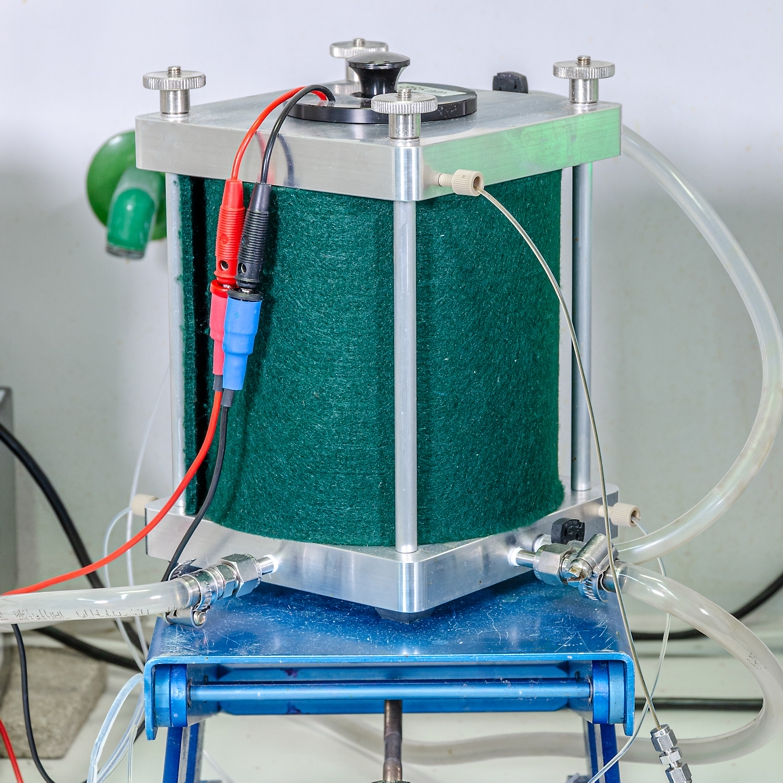Dissertation Christoph Deckers
Flow (photo-)chemistry and online spectroscopy for synthesis and analysis of fine chemicals
We congratulate Christoph Deckers on the successful defense of his doctoral thesis on "Flow (Photo-)Chemistry and Online Spectroscopy for Synthesis and Analysis of Fine Chemicals". In his thesis, Deckers presents new concepts, which all deal with syntheses of fine chemicals while using the benefits of continuous flow approaches and micro reaction technology.
The thesis is divided into two major sections: The first part is about the synthesis of substituted biphenyls including the integration of an online analysis tool. The second topic of this thesis deals with automation and digitalization of continuous processes in research and development towards self-learning facilities.
Christoph Deckers is a research associate in the Division Chemistry at Fraunhofer IMM. The defense of his dissertation on "Flow (Photo-)Chemistry and Online Spectroscopy for Synthesis and Analysis of Fine Chemicals" took place on December 19, 2022 at the Johannes Gutenberg University Mainz.
Abstract

New concepts are presented in this thesis, which all deal with syntheses of fine chemicals while using the benefits of continuous flow approaches and micro reaction technology.
The first part is about the synthesis of substituted biphenyls including the integration of an online analysis tool. While classic methods use transition metal-catalyzed cross coupling reactions, a photochemical pathway for a direct C-H arylation of arenes via diazonium salts is chosen in the presented thesis. As common diazonium tetrafluoroborate salts fail, soluble aryl diazonium trifluoroacetates must be introduced. The new route, where meta-(trifluoromethyl)biphenyl is used as a benchmark molecule, is optimized and compared to literature-known concepts. Better conversion and selectivity towards the favored product are successfully aspired, while mild conditions can be applied.
Two reactor concepts, the falling film micro reactor (FFMR) and the capillary photoreactor are tested. Both are suitable concepts and allow the handling of solid photocatalysts, like titanium(IV) oxide. The photochemical synthesis of the benchmark molecule is feasible in the FFMR, but the overall performance is low at first. This does not highlight the beneficial effects of the micro reactor technology.
Therefore, the capillary photoreactor is put into focus, allowing a much longer irradiation time of the process medium. With the Serial Micro Batch Reactor (SMBR), concept it is possible to introduce even solid photocatalysts as a multiphase plug flow system. This allows an adequate excitation of the photocatalytic active species at 455 nm and the production of the benchmark molecule.
Permanent improvements in the synthesis of the diazonium compound and the overall process lead to a significant increase in conversion and selectivity. Best results are achieved when diazonium trifluoroacetates are synthesized using two equivalents of trifluoroacetic acid. The catalyst-free direct C-H photoarylations of benzene-derivatives are performed by the formation of charge-transfer complexes. These are excited with UV-A light and biphenyl formation results. Continuous syntheses of 13 different samples are successfully carried out and quantified via online 19F-NMR spectroscopy, as the fluorine-containing substituents act as a probe. Therefore, online NMR-spectroscopy is a perfect tool to monitor the continuously operated system, which produces fine chemicals of industrial relevance in the multigram scale.
The second topic of this thesis deals with automation and digitalization of continuous processes in research and development towards self-learning facilities. Self-optimization can be realized by artificial intelligence which is connected to an open and flexible control- and analysis platform. The software has to receive data and information on the condition of the process via sensors and process analytical technology (PAT) systems. Not every online analysis tool is suitable to cover the complete and complex process. Therefore, it is necessary to understand the behavior of the process mixture to realize an appropriate integration of different online spectrometers.
A (semi-)automated lab reactor system, controlled by a self-developed software, is designed to control the continuous two-step synthesis of Z-stilbene. In this model process, both stilbene-isomers are obtained by the well-known Wittig reaction. After quenching the reaction, online process analysis (NMR-, UV/Vis- and IR-spectroscopy) is implemented to analyze the first step with respect to conversion and selectivity.
A photosensitizer is subsequently added to the product-stream and a photoisomerization step towards the favored product is conducted at 455 nm. A nondispersive IR-sensor is used to monitor the isomerization.
The software is designed to be operated in semi-automated mode. This mode is used for quick parameter screening (DoE). The program sequence can be easily converted into a fully automated self-learning process by “one click” if artificial intelligence is integrated.
Testing the modular spectroscopy modules reveals pitfalls in integration for reliable online quantification. Not every analyzer can be successfully integrated, especially in early stages of process development. A precise determination of background and reference signal is mandatory to achieve high accuracy.
 Fraunhofer Institute for Microengineering and Microsystems IMM
Fraunhofer Institute for Microengineering and Microsystems IMM